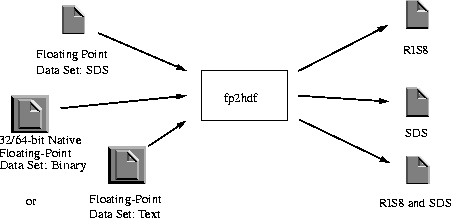1.0, 2.0, 3.0, . . .. Scales may be omitted in an HDF file; they must be included in a text file.
FIGURE 15a - The fp2hdf Utility

15.4.2 Command-line Syntax
The syntax of fp2hdf is as follows.
fp2hdf input-filename [input-filename] -o output-filename
[-r] [-f]
[-e|-i horizontal-resolution vertical-resolution depth]
[-p palette-filename]
[-m mean]
fp2hdf -hThe input-filename parameter is the name of the file containing the unconverted data set. The file may contain a single two-dimensional or three-dimensional floating point array in ASCII text, native floating point, or HDF SDS format. If an HDF file is used for input, it must contain an SDS. The SDS need only contain a dimension record and the data, but if it also contains maximum and minimum values and/or scales for each axis, these will be used. If the format is ASCII text or native floating point, see the discussion at the end of this section regarding the required structure of the data.
The output-filename parameter is the name of the output file containing the converted data set in HDF format. Depending on the output options, output-filename contains a scientific data set and/or raster image set for each of the data sets in the input files.
The fp2hdf options and parameters are described in Table 15E.